Abstract
The ecology of hydrocarbon degradation by microbial populations in the natural environment is reviewed, emphasizing the physical, chemical, and biological factors that contribute to the biodegradation of petroleum and individual hydrocarbons. Rates of biodegradation depend greatly on the composition, state, and concentration of the oil or hydrocarbons, with dispersion and emulsification enhancing rates in aquatic systems and absorption by soil particulates being the key feature of terrestrial ecosystems. Temperature and oxygen and nutrient concentrations are important variables in both types of environments. Salinity and pressure may also affect biodegradation rates in some aquatic environments, and moisture and pH may limit biodegradation in soils. Hydrocarbons are degraded primarily by bacteria and fungi. Adaptation by prior exposure of microbial communities to hydrocarbons increases hydrocarbon degradation rates. Adaptation is brought about by selective enrichment of hydrocarbon-utilizing microorganisms and amplification of the pool of hydrocarbon-catabolizing genes. The latter phenomenon can now be monitored through the use of DNA probes. Increases in plasmid frequency may also be associated with genetic adaptation. Seeding to accelerate rates of biodegradation has been shown to be effective in some cases, particularly when used under controlled conditions, such as in fermentors or chemostats.
Full text
PDF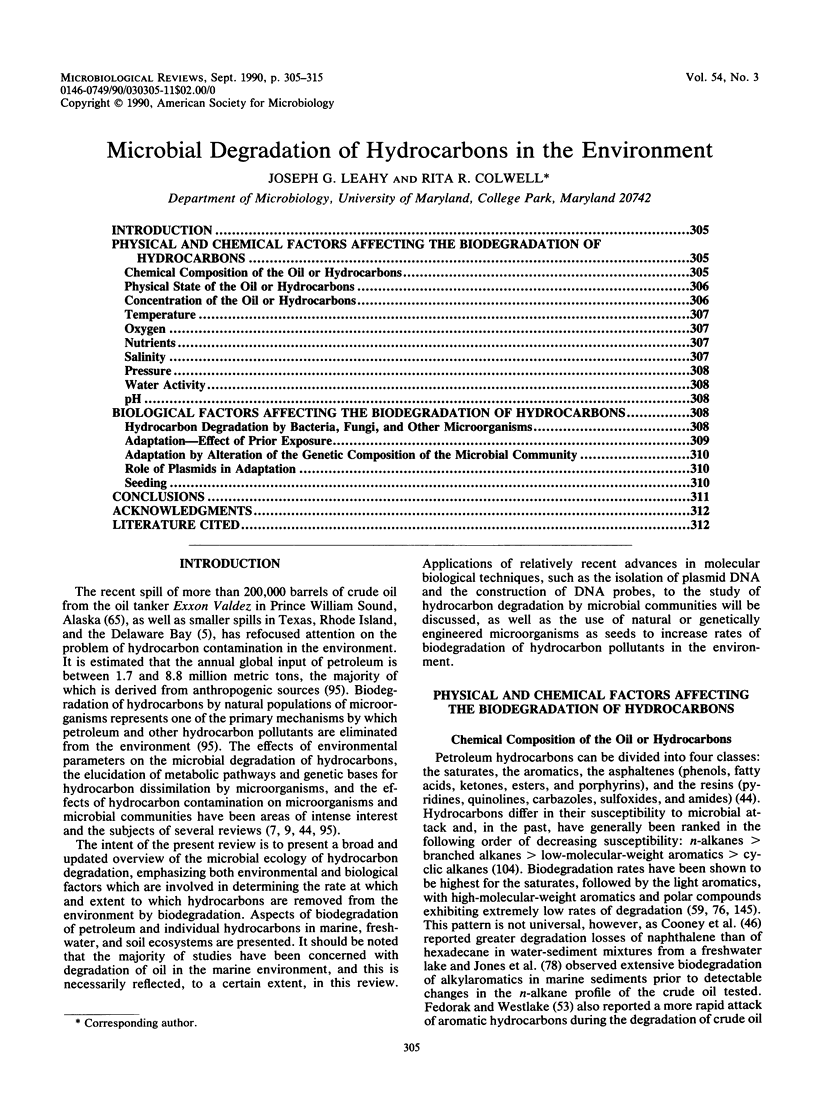
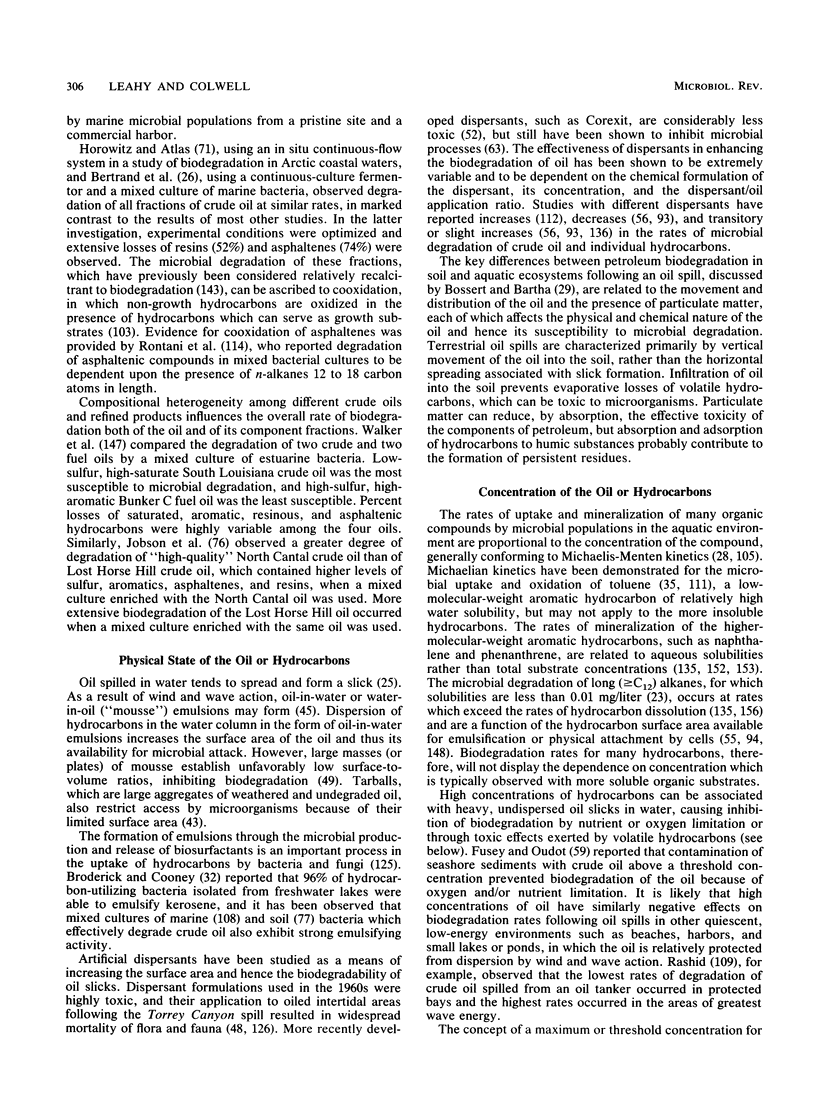
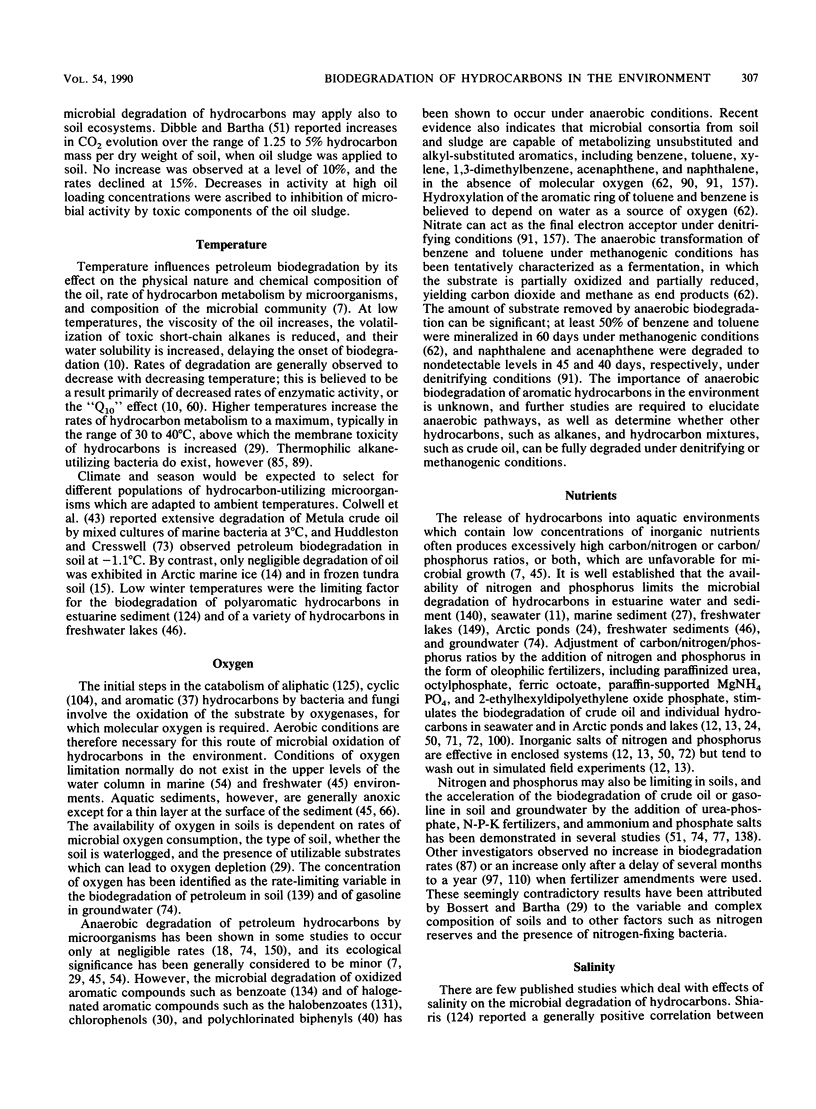
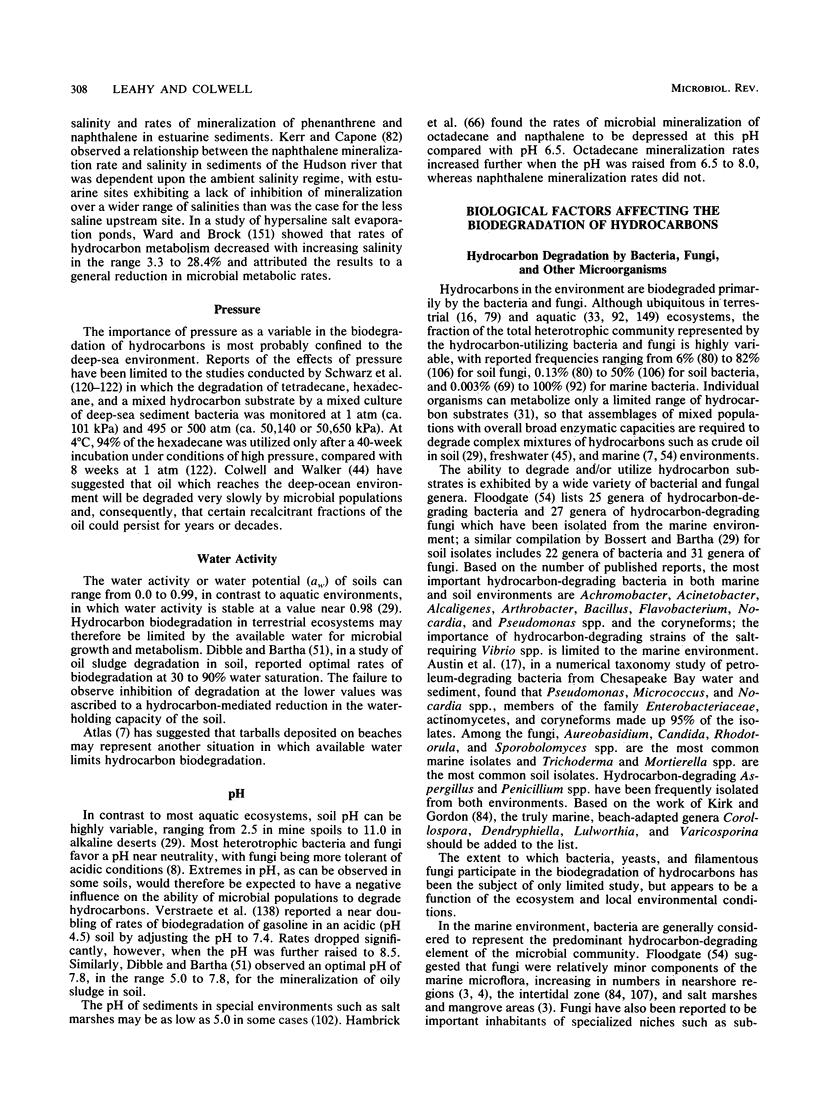
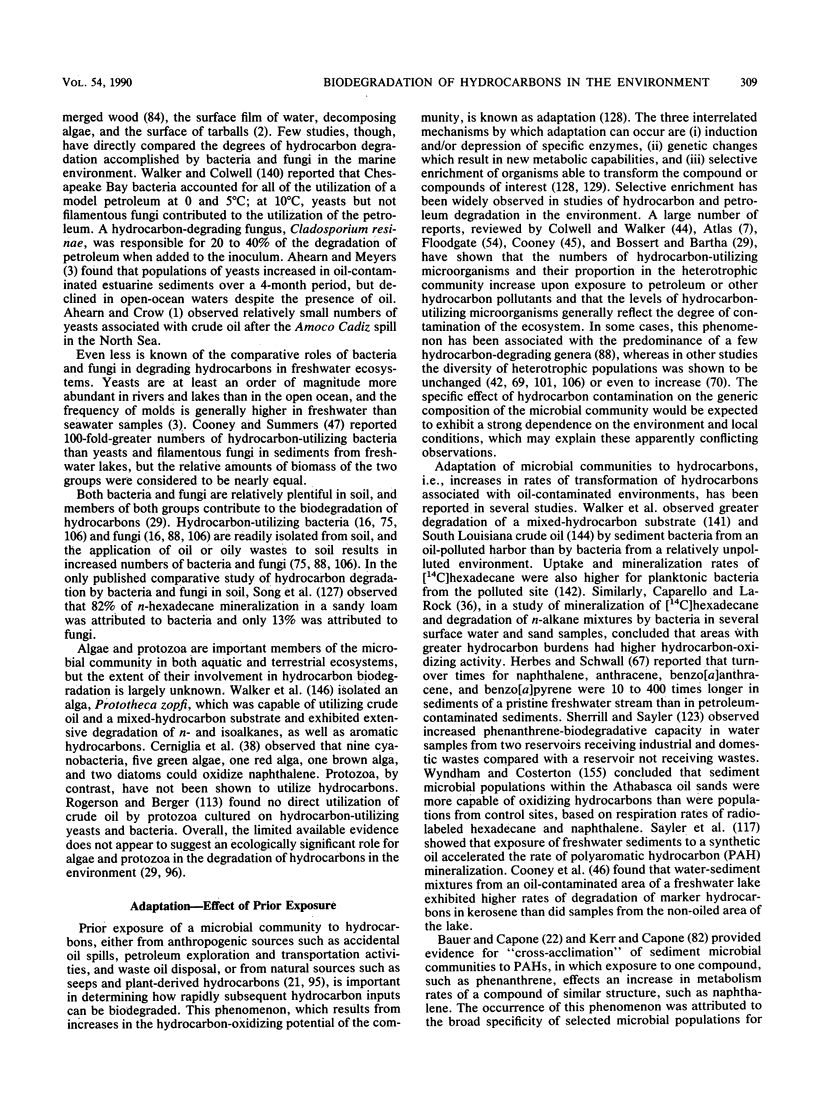
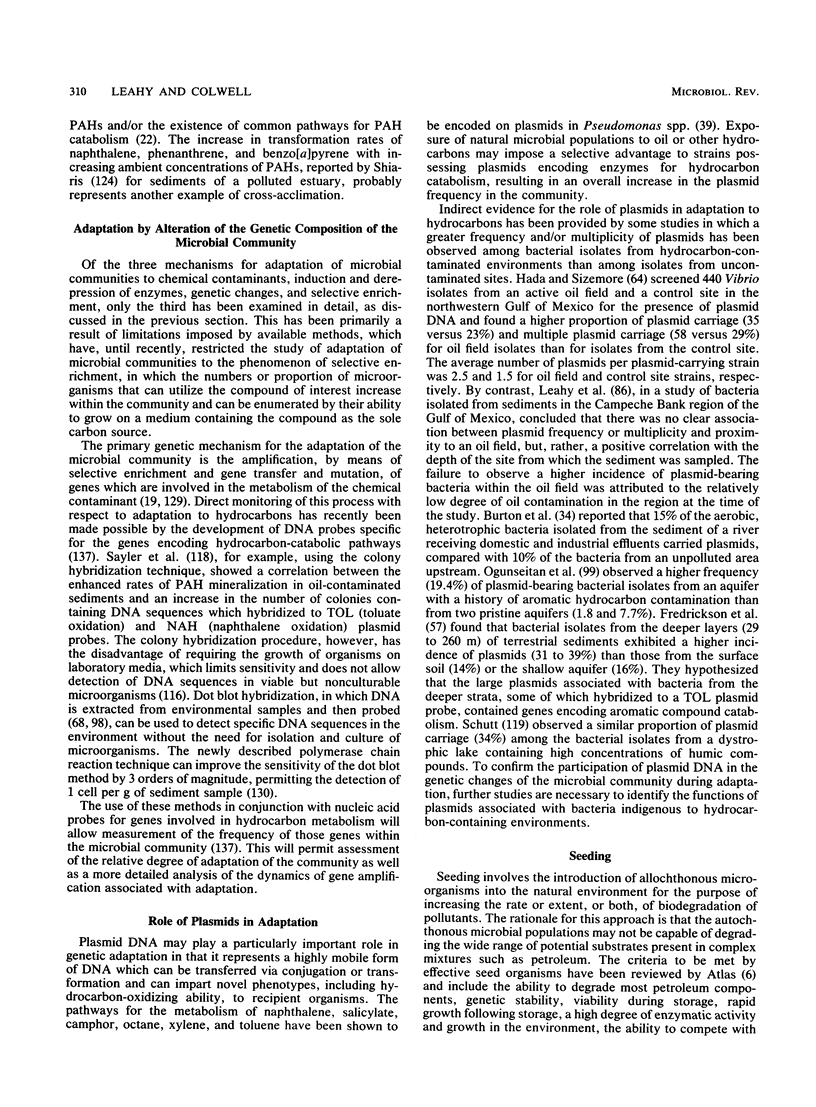
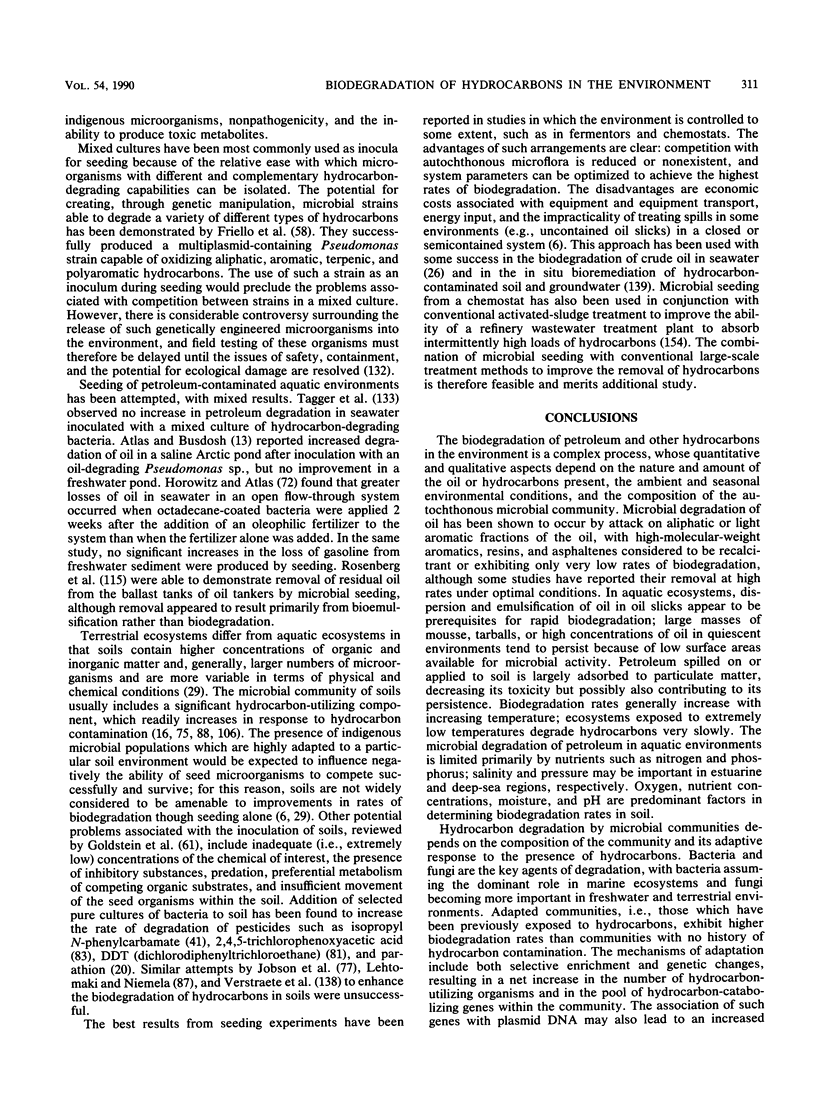
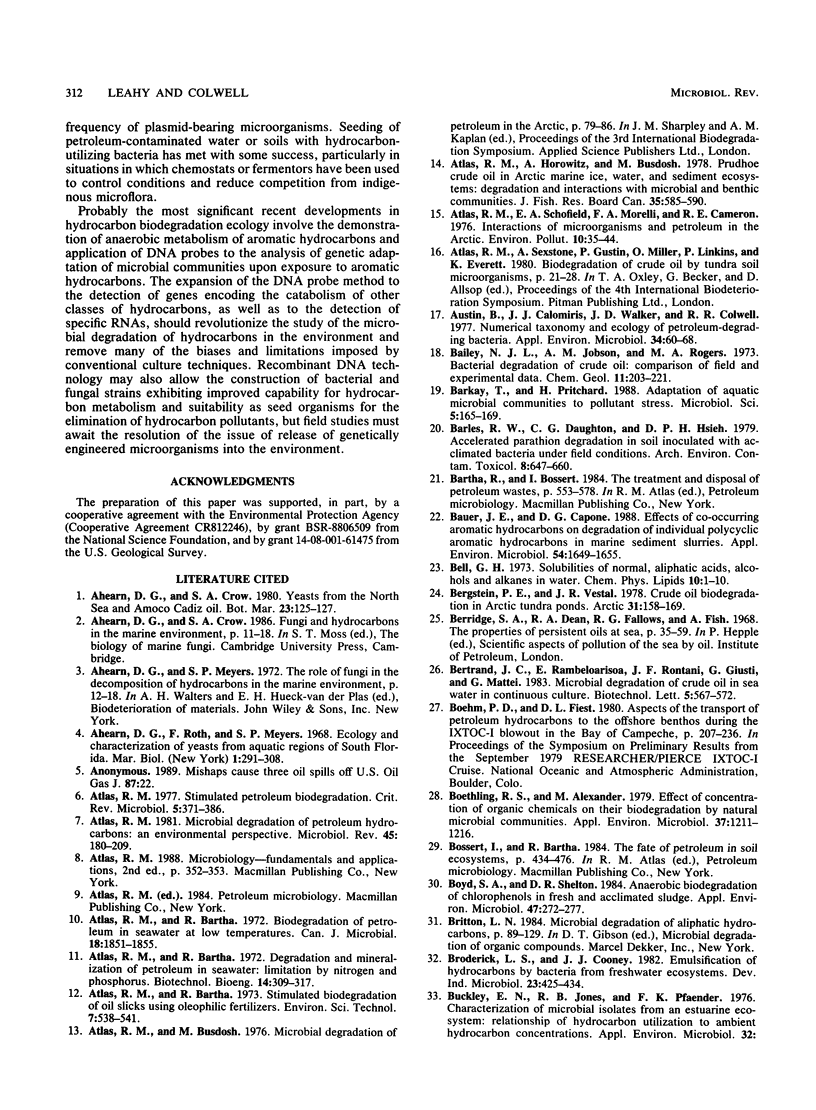
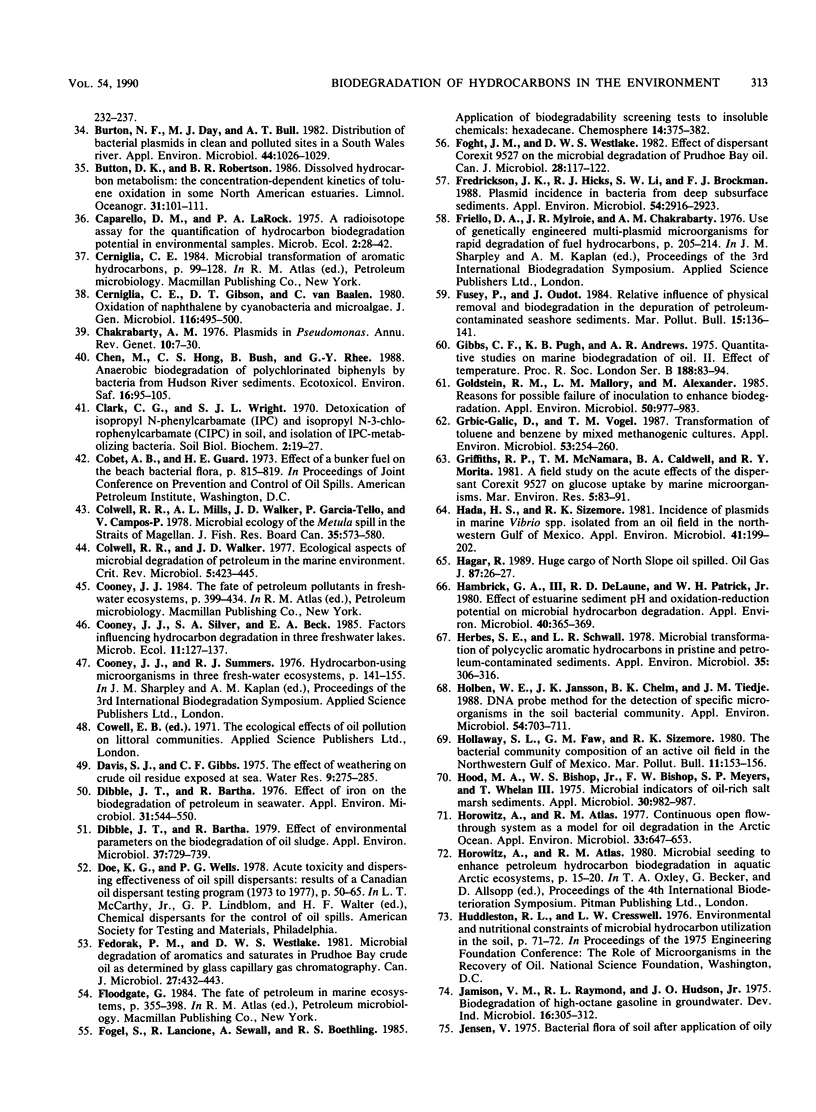
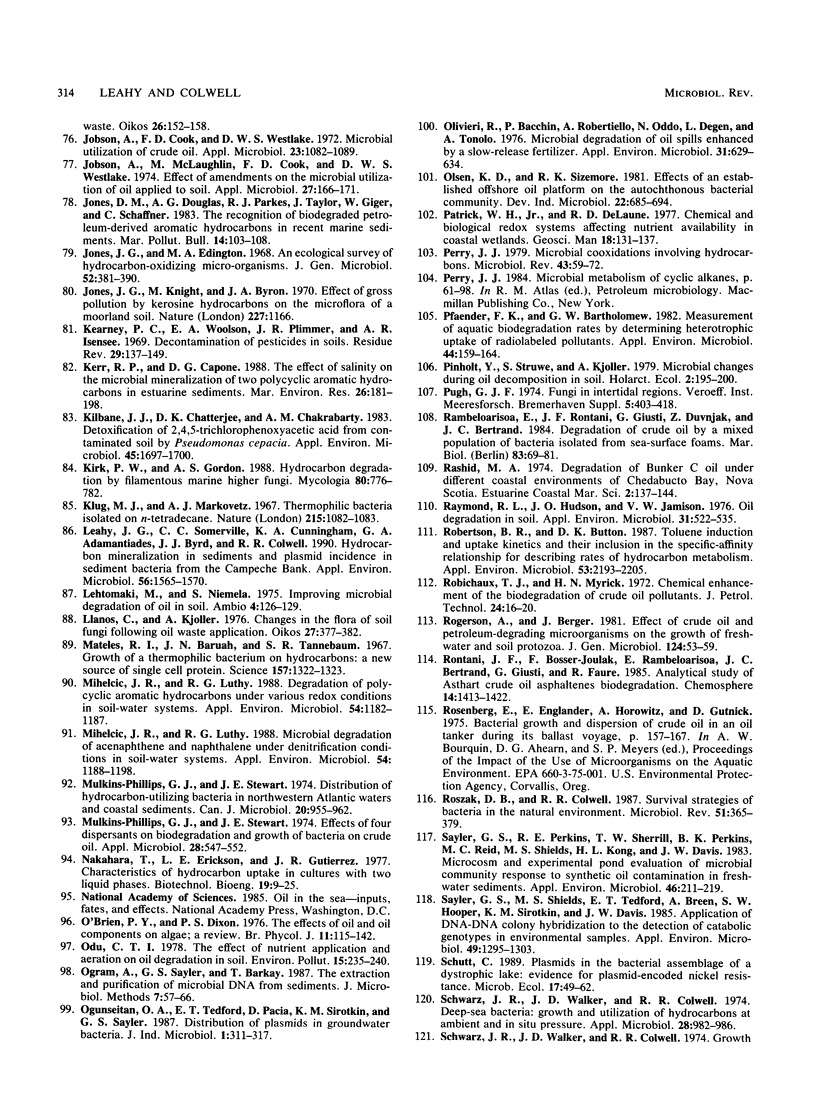
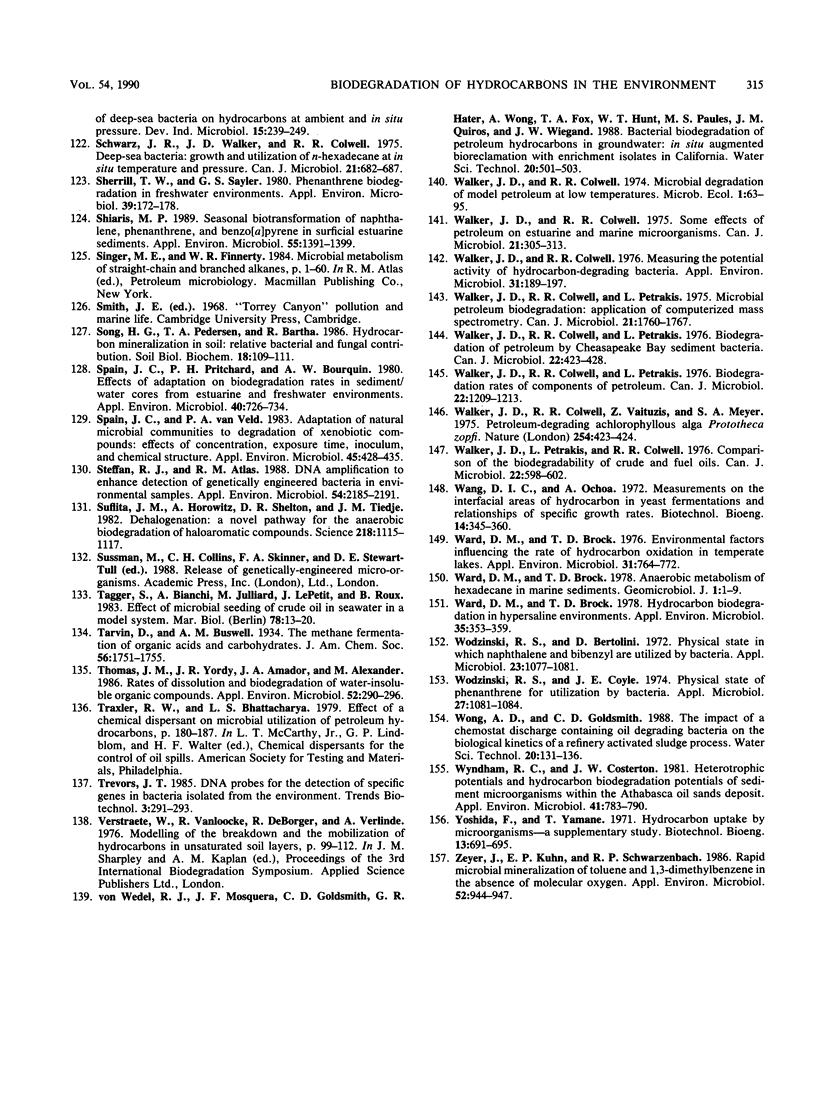
Selected References
These references are in PubMed. This may not be the complete list of references from this article.
- Atlas R. M., Bartha R. Biodegradation of petroleum in seawater at low temperatures. Can J Microbiol. 1972 Dec;18(12):1851–1855. doi: 10.1139/m72-289. [DOI] [PubMed] [Google Scholar]
- Atlas R. M., Bartha R. Degradation and mineralization of petroleum in sea water: limitation by nitrogen and phosphorous. Biotechnol Bioeng. 1972 May;14(3):309–318. doi: 10.1002/bit.260140304. [DOI] [PubMed] [Google Scholar]
- Atlas R. M. Microbial degradation of petroleum hydrocarbons: an environmental perspective. Microbiol Rev. 1981 Mar;45(1):180–209. doi: 10.1128/mr.45.1.180-209.1981. [DOI] [PMC free article] [PubMed] [Google Scholar]
- Atlas R. M. Stimulated petroleum biodegradation. CRC Crit Rev Microbiol. 1977 Sep;5(4):371–386. doi: 10.3109/10408417709102810. [DOI] [PubMed] [Google Scholar]
- Austin B., Calomiris J. J., Walker J. D., Colwell R. R. Numerical taxonomy and ecology of petroleum-degrading bacteria. Appl Environ Microbiol. 1977 Jul;34(1):60–68. doi: 10.1128/aem.34.1.60-68.1977. [DOI] [PMC free article] [PubMed] [Google Scholar]
- Barkay T., Pritchard H. Adaptation of aquatic microbial communities to pollutant stress. Microbiol Sci. 1988 Jun;5(6):165–169. [PubMed] [Google Scholar]
- Barles R. W., Daughton C. G., Hsieh D. P. Accelerated parathion degradation in soil inoculated with acclimated bacteria under field conditions. Arch Environ Contam Toxicol. 1979;8(6):647–660. doi: 10.1007/BF01054867. [DOI] [PubMed] [Google Scholar]
- Bauer J. E., Capone D. G. Effects of co-occurring aromatic hydrocarbons on degradation of individual polycyclic aromatic hydrocarbons in marine sediment slurries. Appl Environ Microbiol. 1988 Jul;54(7):1649–1655. doi: 10.1128/aem.54.7.1649-1655.1988. [DOI] [PMC free article] [PubMed] [Google Scholar]
- Boethling R. S., Alexander M. Effect of concentration of organic chemicals on their biodegradation by natural microbial communities. Appl Environ Microbiol. 1979 Jun;37(6):1211–1216. doi: 10.1128/aem.37.6.1211-1216.1979. [DOI] [PMC free article] [PubMed] [Google Scholar]
- Boyd S. A., Shelton D. R. Anaerobic biodegradation of chlorophenols in fresh and acclimated sludge. Appl Environ Microbiol. 1984 Feb;47(2):272–277. doi: 10.1128/aem.47.2.272-277.1984. [DOI] [PMC free article] [PubMed] [Google Scholar]
- Burton N. F., Day M. J., Bull A. T. Distribution of bacterial plasmids in clean and polluted sites in a South Wales river. Appl Environ Microbiol. 1982 Nov;44(5):1026–1029. doi: 10.1128/aem.44.5.1026-1029.1982. [DOI] [PMC free article] [PubMed] [Google Scholar]
- Chakrabarty A. M. Plasmids in Pseudomonas. Annu Rev Genet. 1976;10:7–30. doi: 10.1146/annurev.ge.10.120176.000255. [DOI] [PubMed] [Google Scholar]
- Chen M., Hong C. S., Bush B., Rhee G. Y. Anaerobic biodegradation of polychlorinated biphenyls by bacteria from Hudson River sediments. Ecotoxicol Environ Saf. 1988 Oct;16(2):95–105. doi: 10.1016/0147-6513(88)90022-x. [DOI] [PubMed] [Google Scholar]
- Colwell R. R. Ecological aspects of microbial degradation of petroleum in the marine environment. CRC Crit Rev Microbiol. 1977 Sep;5(4):423–445. doi: 10.3109/10408417709102813. [DOI] [PubMed] [Google Scholar]
- Dibble J. T., Bartha R. Effect of environmental parameters on the biodegradation of oil sludge. Appl Environ Microbiol. 1979 Apr;37(4):729–739. doi: 10.1128/aem.37.4.729-739.1979. [DOI] [PMC free article] [PubMed] [Google Scholar]
- Dibble J. T., Bartha R. Effect of iron on the biodegradation of petroleum in seawater. Appl Environ Microbiol. 1976 Apr;31(4):544–550. doi: 10.1128/aem.31.4.544-550.1976. [DOI] [PMC free article] [PubMed] [Google Scholar]
- Fedorak P. M., Westlake D. W. Microbial degradation of aromatics and saturates in Prudhoe Bay crude oil as determined by glass capillary gas chromatography. Can J Microbiol. 1981 Apr;27(4):432–443. doi: 10.1139/m81-066. [DOI] [PubMed] [Google Scholar]
- Fredrickson J. K., Hicks R. J., Li S. W., Brockman F. J. Plasmid incidence in bacteria from deep subsurface sediments. Appl Environ Microbiol. 1988 Dec;54(12):2916–2923. doi: 10.1128/aem.54.12.2916-2923.1988. [DOI] [PMC free article] [PubMed] [Google Scholar]
- Gibbs C. F., Pugh K. B., Andrews A. R. Quantitative studies on marine biodegradation of oil. II. Effect of temperature. Proc R Soc Lond B Biol Sci. 1975 Jan 21;188(1090):83–94. doi: 10.1098/rspb.1975.0004. [DOI] [PubMed] [Google Scholar]
- Goldstein R. M., Mallory L. M., Alexander M. Reasons for possible failure of inoculation to enhance biodegradation. Appl Environ Microbiol. 1985 Oct;50(4):977–983. doi: 10.1128/aem.50.4.977-983.1985. [DOI] [PMC free article] [PubMed] [Google Scholar]
- Grbić-Galić D., Vogel T. M. Transformation of toluene and benzene by mixed methanogenic cultures. Appl Environ Microbiol. 1987 Feb;53(2):254–260. doi: 10.1128/aem.53.2.254-260.1987. [DOI] [PMC free article] [PubMed] [Google Scholar]
- Hada H. S., Sizemore R. K. Incidence of Plasmids in Marine Vibrio spp. Isolated from an Oil Field in the Northwestern Gulf of Mexico. Appl Environ Microbiol. 1981 Jan;41(1):199–202. doi: 10.1128/aem.41.1.199-202.1981. [DOI] [PMC free article] [PubMed] [Google Scholar]
- Hambrick G. A., Delaune R. D., Patrick W. H. Effect of Estuarine Sediment pH and Oxidation-Reduction Potential on Microbial Hydrocarbon Degradation. Appl Environ Microbiol. 1980 Aug;40(2):365–369. doi: 10.1128/aem.40.2.365-369.1980. [DOI] [PMC free article] [PubMed] [Google Scholar]
- Herbes S. E., Schwall L. R. Microbial transformation of polycyclic aromatic hydrocarbons in pristine and petroleum-contaminated sediments. Appl Environ Microbiol. 1978 Feb;35(2):306–316. doi: 10.1128/aem.35.2.306-316.1978. [DOI] [PMC free article] [PubMed] [Google Scholar]
- Holben William E., Jansson Janet K., Chelm Barry K., Tiedje James M. DNA Probe Method for the Detection of Specific Microorganisms in the Soil Bacterial Community. Appl Environ Microbiol. 1988 Mar;54(3):703–711. doi: 10.1128/aem.54.3.703-711.1988. [DOI] [PMC free article] [PubMed] [Google Scholar]
- Hood M. A., Bishop W. S., Bishop F. W., Meyers S. P., Whelan T. Microbial indicators of oil-rich salt marsh sediments. Appl Microbiol. 1975 Dec;30(6):982–987. doi: 10.1128/am.30.6.982-987.1975. [DOI] [PMC free article] [PubMed] [Google Scholar]
- Horowitz A., Atlas R. M. Continuous open flow-through system as a model for oil degradation in the arctic ocean. Appl Environ Microbiol. 1977 Mar;33(3):647–653. doi: 10.1128/aem.33.3.647-653.1977. [DOI] [PMC free article] [PubMed] [Google Scholar]
- Jobson A., Cook F. D., Westlake D. W. Microbial utilization of crude oil. Appl Microbiol. 1972 Jun;23(6):1082–1089. doi: 10.1128/am.23.6.1082-1089.1972. [DOI] [PMC free article] [PubMed] [Google Scholar]
- Jobson A., McLaughlin M., Cook F. D., Westlake D. W. Effect of amendments on the microbial utilization of oil applied to soil. Appl Microbiol. 1974 Jan;27(1):166–171. doi: 10.1128/am.27.1.166-171.1974. [DOI] [PMC free article] [PubMed] [Google Scholar]
- Jones J. G., Knight M., Byrom J. A. Effect of gross pollution by kerosine hydrocarbons on the Microflora of a moorland soil. Nature. 1970 Sep 12;227(5263):1166–1166. doi: 10.1038/2271166a0. [DOI] [PubMed] [Google Scholar]
- Kearney P. C., Woolson E. A., Plimmer J. R., Isensee A. R. Decontamination of pesticides in soils. Residue Rev. 1969;29:137–149. doi: 10.1007/978-1-4615-8455-1_10. [DOI] [PubMed] [Google Scholar]
- Kilbane J. J., Chatterjee D. K., Chakrabarty A. M. Detoxification of 2,4,5-trichlorophenoxyacetic acid from contaminated soil by Pseudomonas cepacia. Appl Environ Microbiol. 1983 May;45(5):1697–1700. doi: 10.1128/aem.45.5.1697-1700.1983. [DOI] [PMC free article] [PubMed] [Google Scholar]
- Klug M. J., Markovetz A. J. Thermophilic bacterium isolated on n-tetradecane. Nature. 1967 Sep 2;215(5105):1082–1083. doi: 10.1038/2151082a0. [DOI] [PubMed] [Google Scholar]
- Leahy J. G., Somerville C. C., Cunningham K. A., Adamantiades G. A., Byrd J. J., Colwell R. R. Hydrocarbon mineralization in sediments and plasmid incidence in sediment bacteria from the campeche bank. Appl Environ Microbiol. 1990 Jun;56(6):1565–1570. doi: 10.1128/aem.56.6.1565-1570.1990. [DOI] [PMC free article] [PubMed] [Google Scholar]
- Mateles R. I., Baruah J. N., Tannenbaum S. R. Growth of a thermophilic bacterium on hydrocarbons: a new source of single-cell protein. Science. 1967 Sep 15;157(3794):1322–1323. doi: 10.1126/science.157.3794.1322. [DOI] [PubMed] [Google Scholar]
- Mihelcic J. R., Luthy R. G. Degradation of polycyclic aromatic hydrocarbon compounds under various redox conditions in soil-water systems. Appl Environ Microbiol. 1988 May;54(5):1182–1187. doi: 10.1128/aem.54.5.1182-1187.1988. [DOI] [PMC free article] [PubMed] [Google Scholar]
- Mihelcic J. R., Luthy R. G. Microbial degradation of acenaphthene and naphthalene under denitrification conditions in soil-water systems. Appl Environ Microbiol. 1988 May;54(5):1188–1198. doi: 10.1128/aem.54.5.1188-1198.1988. [DOI] [PMC free article] [PubMed] [Google Scholar]
- Mulkins-Phillips G. J., Stewart J. E. Distribution of hydrocarbon-utilizing bacteria in Northwestern Atlantic waters and coastal sediments. Can J Microbiol. 1974 Jul;20(7):955–956. doi: 10.1139/m74-147. [DOI] [PubMed] [Google Scholar]
- Mulkins-Phillips G. J., Stewart J. E. Effect of four dispersants on biodegradation and growth of bacteria on crude oil. Appl Microbiol. 1974 Oct;28(4):547–552. doi: 10.1128/am.28.4.547-552.1974. [DOI] [PMC free article] [PubMed] [Google Scholar]
- Nakahara T., Erickson L. E., Gutierrez J. R. Characteristics of hydrocarbon uptake in cultures with two liquid phases. Biotechnol Bioeng. 1977 Jan;19(1):9–25. doi: 10.1002/bit.260190103. [DOI] [PubMed] [Google Scholar]
- Olivieri R., Bacchin P., Robertiello A., Oddo N., Degen L., Tonolo A. Microbial degradation of oil spills enhanced by a slow-release fertilizer. Appl Environ Microbiol. 1976 May;31(5):629–634. doi: 10.1128/aem.31.5.629-634.1976. [DOI] [PMC free article] [PubMed] [Google Scholar]
- Perry J. J. Microbial cooxidations involving hydrocarbons. Microbiol Rev. 1979 Mar;43(1):59–72. doi: 10.1128/mr.43.1.59-72.1979. [DOI] [PMC free article] [PubMed] [Google Scholar]
- Pfaender F. K., Bartholomew G. W. Measurement of aquatic biodegradation rates by determining heterotrophic uptake of radiolabeled pollutants. Appl Environ Microbiol. 1982 Jul;44(1):159–164. doi: 10.1128/aem.44.1.159-164.1982. [DOI] [PMC free article] [PubMed] [Google Scholar]
- Raymond R. L., Hudson J. O., Jamison V. W. Oil degradation in soil. Appl Environ Microbiol. 1976 Apr;31(4):522–535. doi: 10.1128/aem.31.4.522-535.1976. [DOI] [PMC free article] [PubMed] [Google Scholar]
- Robertson B. R., Button D. K. Toluene induction and uptake kinetics and their inclusion in the specific-affinity relationship for describing rates of hydrocarbon metabolism. Appl Environ Microbiol. 1987 Sep;53(9):2193–2205. doi: 10.1128/aem.53.9.2193-2205.1987. [DOI] [PMC free article] [PubMed] [Google Scholar]
- Roszak D. B., Colwell R. R. Survival strategies of bacteria in the natural environment. Microbiol Rev. 1987 Sep;51(3):365–379. doi: 10.1128/mr.51.3.365-379.1987. [DOI] [PMC free article] [PubMed] [Google Scholar]
- Sayler G. S., Perkins R. E., Sherrill T. W., Perkins B. K., Reid M. C., Shields M. S., Kong H. L., Davis J. W. Microcosm and experimental pond evaluation of microbial community response to synthetic oil contamination in freshwater sediments. Appl Environ Microbiol. 1983 Jul;46(1):211–219. doi: 10.1128/aem.46.1.211-219.1983. [DOI] [PMC free article] [PubMed] [Google Scholar]
- Sayler G. S., Shields M. S., Tedford E. T., Breen A., Hooper S. W., Sirotkin K. M., Davis J. W. Application of DNA-DNA colony hybridization to the detection of catabolic genotypes in environmental samples. Appl Environ Microbiol. 1985 May;49(5):1295–1303. doi: 10.1128/aem.49.5.1295-1303.1985. [DOI] [PMC free article] [PubMed] [Google Scholar]
- Schwarz J. R., Walder J. D., Colwell R. R. Deep-sea bacteria: growth and utilization of hydrocarbons at ambient and in situ pressure. Appl Microbiol. 1974 Dec;28(6):982–986. doi: 10.1128/am.28.6.982-986.1974. [DOI] [PMC free article] [PubMed] [Google Scholar]
- Schwarz J. R., Walker J. D., Colwell R. R. Deep-sea bacteria: growth and utilization of n-hexadecane at in situ temperature and pressure. Can J Microbiol. 1975 May;21(5):682–687. doi: 10.1139/m75-098. [DOI] [PubMed] [Google Scholar]
- Sherrill T. W., Sayler G. S. Phenanthrene biodegradation in freshwater environments. Appl Environ Microbiol. 1980 Jan;39(1):172–178. doi: 10.1128/aem.39.1.172-178.1980. [DOI] [PMC free article] [PubMed] [Google Scholar]
- Shiaris M. P. Seasonal Biotransformation of Naphthalene, Phenanthrene, and Benzo[a]pyrene in Surficial Estuarine Sediments. Appl Environ Microbiol. 1989 Jun;55(6):1391–1399. doi: 10.1128/aem.55.6.1391-1399.1989. [DOI] [PMC free article] [PubMed] [Google Scholar]
- Spain J. C., Pritchard P. H., Bourquin A. W. Effects of adaptation on biodegradation rates in sediment/water cores from estuarine and freshwater environments. Appl Environ Microbiol. 1980 Oct;40(4):726–734. doi: 10.1128/aem.40.4.726-734.1980. [DOI] [PMC free article] [PubMed] [Google Scholar]
- Spain J. C., Van Veld P. A. Adaptation of natural microbial communities to degradation of xenobiotic compounds: effects of concentration, exposure time, inoculum, and chemical structure. Appl Environ Microbiol. 1983 Feb;45(2):428–435. doi: 10.1128/aem.45.2.428-435.1983. [DOI] [PMC free article] [PubMed] [Google Scholar]
- Steffan R. J., Atlas R. M. DNA amplification to enhance detection of genetically engineered bacteria in environmental samples. Appl Environ Microbiol. 1988 Sep;54(9):2185–2191. doi: 10.1128/aem.54.9.2185-2191.1988. [DOI] [PMC free article] [PubMed] [Google Scholar]
- Suflita J. M., Horowitz A., Shelton D. R., Tiedje J. M. Dehalogenation: a novel pathway for the anaerobic biodegradation of haloaromatic compounds. Science. 1982 Dec 10;218(4577):1115–1117. doi: 10.1126/science.218.4577.1115. [DOI] [PubMed] [Google Scholar]
- Thomas J. M., Yordy J. R., Amador J. A., Alexander M. Rates of dissolution and biodegradation of water-insoluble organic compounds. Appl Environ Microbiol. 1986 Aug;52(2):290–296. doi: 10.1128/aem.52.2.290-296.1986. [DOI] [PMC free article] [PubMed] [Google Scholar]
- Walker J. D., Colwell R. R. Measuring the potential activity of hydrocarbon-degrading bacteria. Appl Environ Microbiol. 1976 Feb;31(2):189–197. doi: 10.1128/aem.31.2.189-197.1976. [DOI] [PMC free article] [PubMed] [Google Scholar]
- Walker J. D., Colwell R. R., Petrakis L. Biodegradation of petroleum by Chesapeake Bay sediment bacteria. Can J Microbiol. 1976 Mar;22(3):423–428. doi: 10.1139/m76-063. [DOI] [PubMed] [Google Scholar]
- Walker J. D., Colwell R. R., Petrakis L. Biodegradation rates of components of petroleum. Can J Microbiol. 1976 Aug;22(8):1209–1213. doi: 10.1139/m76-179. [DOI] [PubMed] [Google Scholar]
- Walker J. D., Colwell R. R., Petrakis L. Microbial petroleum degradation: application of computerized mass spectrometry. Can J Microbiol. 1975 Nov;21(11):1760–1767. doi: 10.1139/m75-257. [DOI] [PubMed] [Google Scholar]
- Walker J. D., Colwell R. R. Some effects of petroleum on estuarine and marine microorganisms. Can J Microbiol. 1975 Mar;21(3):305–313. doi: 10.1139/m75-044. [DOI] [PubMed] [Google Scholar]
- Walker J. D., Petrakis L., Colwell R. R. Comparison of biodegradability of crude and fuel oils. Can J Microbiol. 1976 Apr;22(4):598–602. doi: 10.1139/m76-089. [DOI] [PubMed] [Google Scholar]
- Wang D. I., Ochoa A. Measurements on the interfacial areas of hydrocarbon in yeast fermentations and relationships to specific growth rates. Biotechnol Bioeng. 1972 May;14(3):345–360. doi: 10.1002/bit.260140307. [DOI] [PubMed] [Google Scholar]
- Ward D. M., Brock T. D. Environmental factors influencing the rate of hydrocarbon oxidation in temperate lakes. Appl Environ Microbiol. 1976 May;31(5):764–772. doi: 10.1128/aem.31.5.764-772.1976. [DOI] [PMC free article] [PubMed] [Google Scholar]
- Ward D. M., Brock T. D. Hydrocarbon biodegradation in hypersaline environments. Appl Environ Microbiol. 1978 Feb;35(2):353–359. doi: 10.1128/aem.35.2.353-359.1978. [DOI] [PMC free article] [PubMed] [Google Scholar]
- Wodzinski R. S., Bertolini D. Physical state in which naphthalene and bibenzyl are utilized by bacteria. Appl Microbiol. 1972 Jun;23(6):1077–1081. doi: 10.1128/am.23.6.1077-1081.1972. [DOI] [PMC free article] [PubMed] [Google Scholar]
- Wodzinski R. S., Coyle J. E. Physical state of phenanthrene for utilization by bacteria. Appl Microbiol. 1974 Jun;27(6):1081–1084. doi: 10.1128/am.27.6.1081-1084.1974. [DOI] [PMC free article] [PubMed] [Google Scholar]
- Wyndham R. C., Costerton J. W. Heterotrophic potentials and hydrocarbon biodegradation potentials of sediment microorganisms within the athabasca oil sands deposit. Appl Environ Microbiol. 1981 Mar;41(3):783–790. doi: 10.1128/aem.41.3.783-790.1981. [DOI] [PMC free article] [PubMed] [Google Scholar]
- Yoshida F., Yamane T. Hydrocarbon uptake by microorganisms--a supplementary study. Biotechnol Bioeng. 1971 Sep;13(5):691–695. doi: 10.1002/bit.260130509. [DOI] [PubMed] [Google Scholar]
- Zeyer J., Kuhn E. P., Schwarzenbach R. P. Rapid microbial mineralization of toluene and 1,3-dimethylbenzene in the absence of molecular oxygen. Appl Environ Microbiol. 1986 Oct;52(4):944–947. doi: 10.1128/aem.52.4.944-947.1986. [DOI] [PMC free article] [PubMed] [Google Scholar]


